What it really means to be an AI-First Startup
From Vision to Execution - What Every Founder Needs to Know About AI-Driven Success
In today’s fast-changing business world, founders face a unique challenge: how to build companies that are not just using technology, but are defined by it. Todays’ post focuses on exploring what it means to be an AI-First startup, where AI helps shape every part of the organization specially startups, from decision-making to talent and everyday operations.
Some of the world’s fastest-growing startups are called “AI-first”these days, but what does that actually mean? What does it mean for a founder to built an AI-first startup from the ground up, and how does this approach changes how startups are run.
We’ are comparing this new model with old ways of working, and breaking down the differences through simple charts, to create a practical roadmap for founders looking to place AI at the heart of their business.
What is an AI-First Company?
Being an AI-first company that is leaner, simpler, flatter, equipped with AI-native talents, dreams bigger, and builds faster means redesigning the entire organizational structure with artificial intelligence as the central nervous system, and not just adding AI to existing processes but fundamentally reimagining decision-making, workflows, and talent to maximize speed, creativity, and efficiency.
Instead of adding agents and AI tools here and there, and using AI wherever possible, because everyone else is doing it? from answering emails to planning new products. the founders strategically plan and start by asking: “How can AI help us do this better or faster?” This means artificial intelligence (AI) isn’t just a tool they run everything around, but it helps with big decisions, daily tasks, and how work is done, from top to bottom.
An AI-first company places artificial intelligence at the core of its business, ensuring that every strategic decision, process, and solution is informed and powered by AI. Instead of simply experimenting with tools, these organizations build from the ground up with AI infrastructure, continually asking how AI can automate, improve, or accelerate every activity.
A Leaner, Simpler, and Flatter Organization
This table diagram below presents the big differences between old-style of working and how the new AI-First startups way of working looks like in comparison. The diagram contrasts two ways of building companies: “traditional” versus “AI-First” and how AI-First startups rethink everything, from structure and decision-making to innovation and growth, helping founders see how much their priorities and also results change with an AI-led approach.It also reflect on how AI changes the way teams work, make decisions, and grow.
Traditional companies are hierarchical and make decisions based on experience, whereas AI-First startups are flat, agile, and rely on data.
Talent in traditional firms focuses on business, while AI-First companies value tech skills and recruit AI-savvy people.
Tech strategy in traditionals is slow and IT-led, but in AI-First, it’s driven by AI and rapid innovation.
Growth and innovation are secondary and occasional in traditionals, but AI-First startups place them at the core, pushing for continuous progress.
By minimizing bureaucracy and reducing layers of management, AI-first organizations can operate with fewer employees and flatter hierarchies which is a must for a startup which are initially built leaner and have fewer roles but extra all around responsibilities. AI can streamline information flow, enable the leaner management and make it more efficient, give employees greater responsibility and autonomy. What happens as a result is that decision speed increases, and teams can move quickly to execute ideas, supported by agile AI systems rather than complex approval chains.
A recent Harvard Business Review study (2025) found that companies embedding AI into decision-making had “dramatically reduced the cost and time of decisions,” with AI-driven teams reimagining workflows and seeing much faster growth.
McKinsey’s 2025 research explained that “future-built” AI companies achieve up to 5 times the revenue growth and 3 times the cost reduction compared to firms sticking to traditional models. Rapid, data-driven decision-making is core to this transformation.
As per another report from BusinessChemistry.org (2025), The AI-first startups move “7x faster in decision speed” and expand their markets “62% quicker” than traditional startups, due to automation and data-driven strategies.
These studies underscore that AI-first companies fundamentally change their pace and impact.
AI-Native Talents and Simple Infrastructure
AI-native talents are professionals who are deeply skilled at working with AI tools and systems infusing AI into every role, function, and process. The infrastructure is simple and adaptable, often cloud-native, designed for rapid iteration and scalability, with minimal overhead. Its important to understand the AI infrastructure from typical or Network Infrastructure, while still part of the enterprise infrastructure and based with in, the core and supporting the entire infrastructure. AI infrastructure uses special hardware (like GPUs), much bigger data storage, and advanced cloud platforms designed to train, test, and run complex AI models and machine learning tasks. So when you add AI infra, you upgrade your systems to handle large data loads, faster processing, and more automation, making your business able to run AI applications.
Founders don’t need to know everything about coding, but they do need to bring people who feel comfortable working with not just AI tools and understanding of how AI can be integrated with in the enterprise, its stack and the elements. they should understand the why and what tasks needs building Agents or multi-agent systems and where it’ll be useful to implement gen AI use cases instead.
Its also possible that not everyone is keen on adapting AI. Some recent surveys show more than 60% of employees feel anxious or resistant towards new AI tools at work. Therefore, It’ also becomes a challenge of creating a culture where learning and change are normal, and the tech is flexible and easy to update, and people are willing to do it. AI-first companies need to encourage continuous experimentation with AI, instead of continuing with traditional methods.
McKinsey found that such organizations achieve up to 10x productivity gains over traditional firms by encouraging ongoing innovation and making it easy to update and use new tech. Progress happens when teams are supported to try, fail, and learn with AI, showing that a growth mindset and flexible technology are as important as the tools themselves.
Dreaming Bigger and Building Faster
If you’re starting a new company or reimagining an old one, making it AI-first gives you the freedom to move faster, dream bigger, and solve harder problems.
The chart above shows, in simple terms, how that AI-First companies do much better than Traditional ones in every key area like speed, innovation, and growth. For example, AI-First companies like Google and Duolingo use AI to automate tasks, test ideas faster, and personalize products, helping them innovate and expand quickly.
Studies from Deloitte and the UK government found that companies adopting AI see up to 25-30% lower costs and large jumps in revenue and new jobs compared to traditional firms. According to research in ScienceDirect and BCG, AI-First businesses grow sales, market value, and creativity much faster than others, with some achieving multi-million dollar revenues with small teams in months, something traditional companies rarely match.
This massive performance difference seen in the chart, where AI-First companies consistently score at the top, prove that AI is a powerful driver of business success. While these studies quote data from big companies, Small startups can also move quickly by picking one main problem to solve with AI, using flexible tools and cloud solutions that don’t require big budgets.
AI- Driven Business Framework
This chart highlights the key building blocks of an AI-driven business, applicable both to startups and large companies, where they need to focus on to succeed with artificial intelligence. Each of these elements in the framework connect directly to practical needs for growth, agility, and trust in the age of AI.
Strategic Alignment:
Companies must set clear goals for how and where AI will drive results, ensuring everyone is working towards the same objectives.Data Infrastructure:
Good data systems are essential; they let companies store, manage, and use information safely for training reliable AI.Governance & Trust:
Protecting privacy, ensuring security, and having strong policies helps build trust with customers and partners.Experimentation:
Businesses must be willing to try new ideas, test AI solutions quickly, and learn from small failures a core trait in startups and a growing focus for big companies.Automation & Agility:
Using AI to automate tasks makes teams faster and frees people to solve bigger problems. Agile systems let companies adapt quickly as markets shift.Upskilling Talent:
Both startups and enterprises need to help their teams learn new AI skills. Studies show that companies investing in upskilling see up to 40% better performance and retention rates.
According to McKinsey’s global survey, organizations that built strong AI foundations across these areas saw double the rate of revenue growth compared to those that only implemented AI in isolated projects. The framework above can help startup do more with less, iterate faster, and compete with bigger rival by embracing continuous experimentation and agile, data-driven workflows often grow up to 5x faster than peers. For the large enterprises, the core focus should be on culture and talent other than the technology itself. Both small startups and big companies can succeed with AI when they align goals, invest in data and talent, and encourage a culture of safe, agile experimentation.
AI Adoption barriers
As more companies try to adopt AI, Its important to understand the biggest challenges other than common roadblocks , that come from messy data to lack of talent, culture clashes, and concerns about ethics, and that can slow down or even stop their progress? Many organizations are excited about using AI, but the journey is often blocked by practical hurdles. Knowing these barriers is the first step to finding ways to overcome them and unlock the advantages of AI and help leaders plan smarter strategies so their teams don’t get stuck before seeing real results from AI.
Here are the top reasons why companies struggle to use AI:
Data Quality Issues (36%) – The biggest barrier is having messy, outdated, or incomplete data.
Talent Shortage (29%) – Many firms lack enough skilled people who understand AI.
Cultural Resistance (21%) – Employees and leaders may resist change or distrust AI.
Ethical Concerns (14%) – Worries about fairness, privacy, and responsible use slow down adoption.
How to overcome these barriers:
Fix data problems by investing in better data collection, cleaning, and management systems.
Bridge the talent gap through upskilling, training programs, and bringing in new experts or partners.
Tackle cultural resistance by communicating benefits clearly, involving staff early, and leading by example with small wins.
Address ethical concerns with strong policies, transparency, regular reviews, and legal guidance to ensure AI is used responsibly.
AI Transformation Timeline
Late 2022 saw the public release of ChatGPT, which brought powerful AI text generation and conversation to everyday users and businesses for the first time.
Before this, from 2020 to 2022, tools like DALL-E, Midjourney, and Stable Diffusion introduced AI-powered image creation to creatives and marketers. By 2023, over 70% of enterprises reported using generative AI in some business function, and consumer adoption surged as these tools became available in common apps, customer support, and personal productivity platforms. This rapid shift means generative AI moved from tech labs to mainstream work and life in just one to two years, changing how we create, communicate, and solve problems.
If we look at the chart above, In 2020, companies started with manual processes, just using basic digital tools. By 2022, they began automating tasks and bringing in simple AI tools, marking the start of digital transformation. Early 2025 is when the boldest startups had become “AI-First,” using smart workflows and advanced AI to manage teams and projects, according to BCG and Forbes reports, a leap from manual work to automation to a bold new world powered by AI, setting the stage for the future of business. The projection show that by 2028, some organizations will reach a point where AI helped run almost everything, marking a new age of autonomous companies with up to 30% faster progress.
This timeline is a snapshot of how far technology has come—showing a revolution from old to new, and how embracing AI is changing the way we work and grow.
Conclusion
The shift from traditional to AI-First is more than a tech upgrade. It’s a reinvention of how companies grow, innovate, and succeed. For founders, embracing an AI-First approach means adopting a flat, agile structure, supporting data-driven decisions, hiring tech-focused talent, and fostering continuous innovation, by making it the core purpose rather than a secondary goal. Founders who can lead with AI not only just keep up with change will set the pace for the future.
Built Around AI, Not Add-Ons
Flatter Teams, Faster Decisions
Automated Innovation and Growth
AI-Native Talent Drives Change
Ahead of Traditional Companies
Tackling Data, Talent, and Culture Challenges
To be AI-fist at the initial stage very much is willingness to let go of old routine and open the door to quicker solutions and new opportunities. With this attitude, even a lean crew can turn ambitions into real achievements faster than expected. Being open-minded, resilient, and proactive is what truly sets remarkable teams apart. The most successful founders would welcome fresh perspectives, take risks, and motivate their teams to pick up new abilities. By staying adaptable and nurturing this kind of environment, they can build nimble companies that rise above challenges even with limited resources.



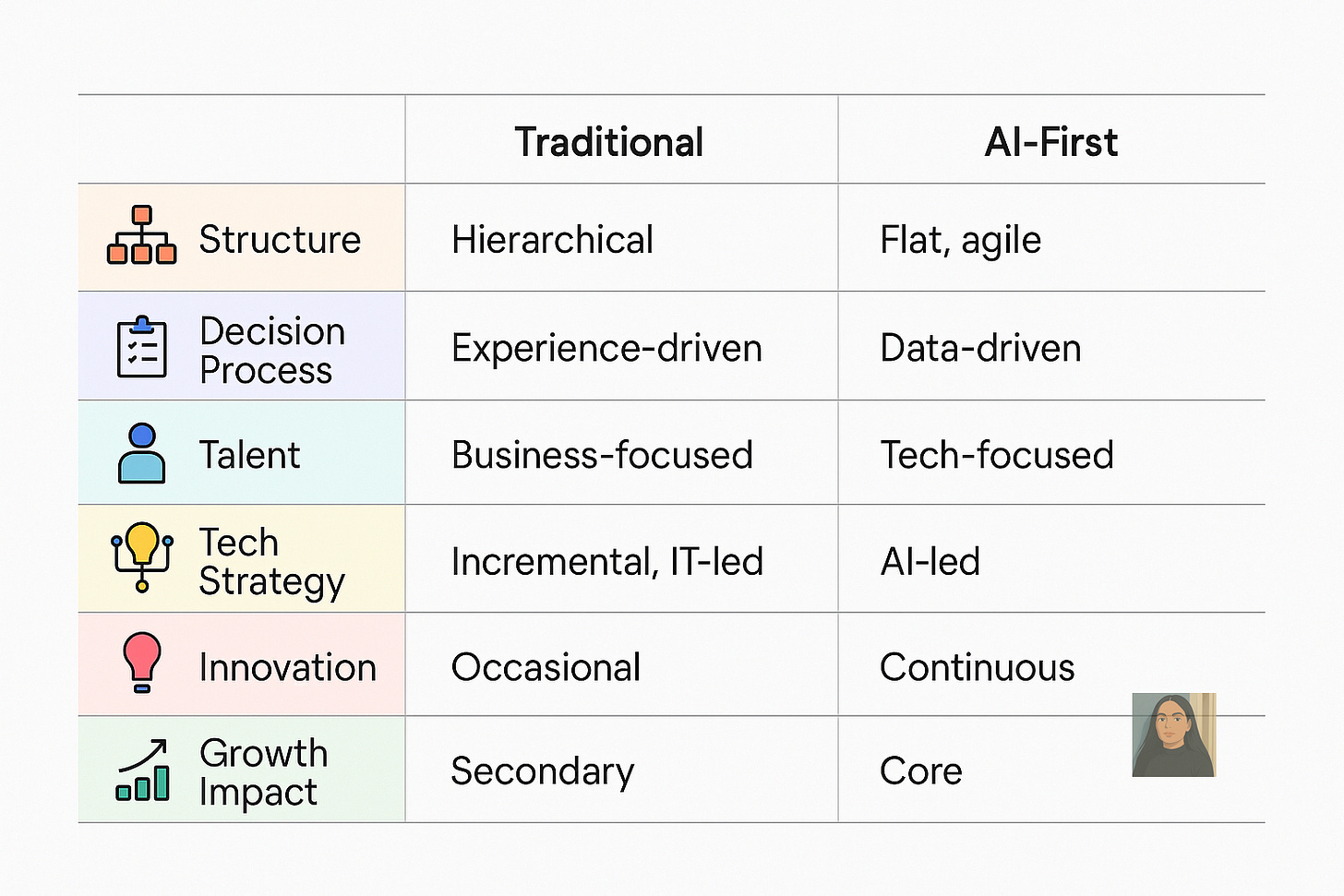
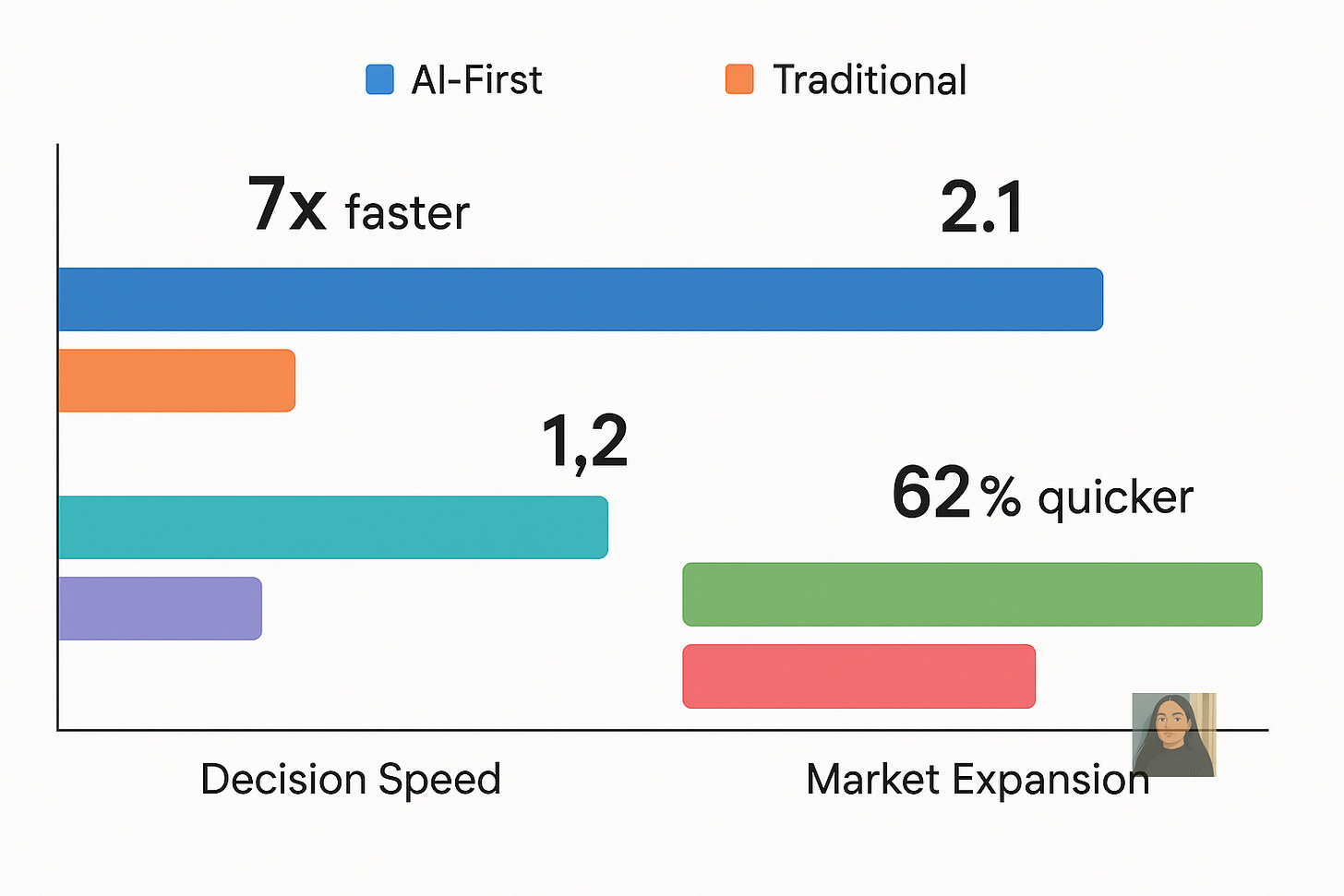

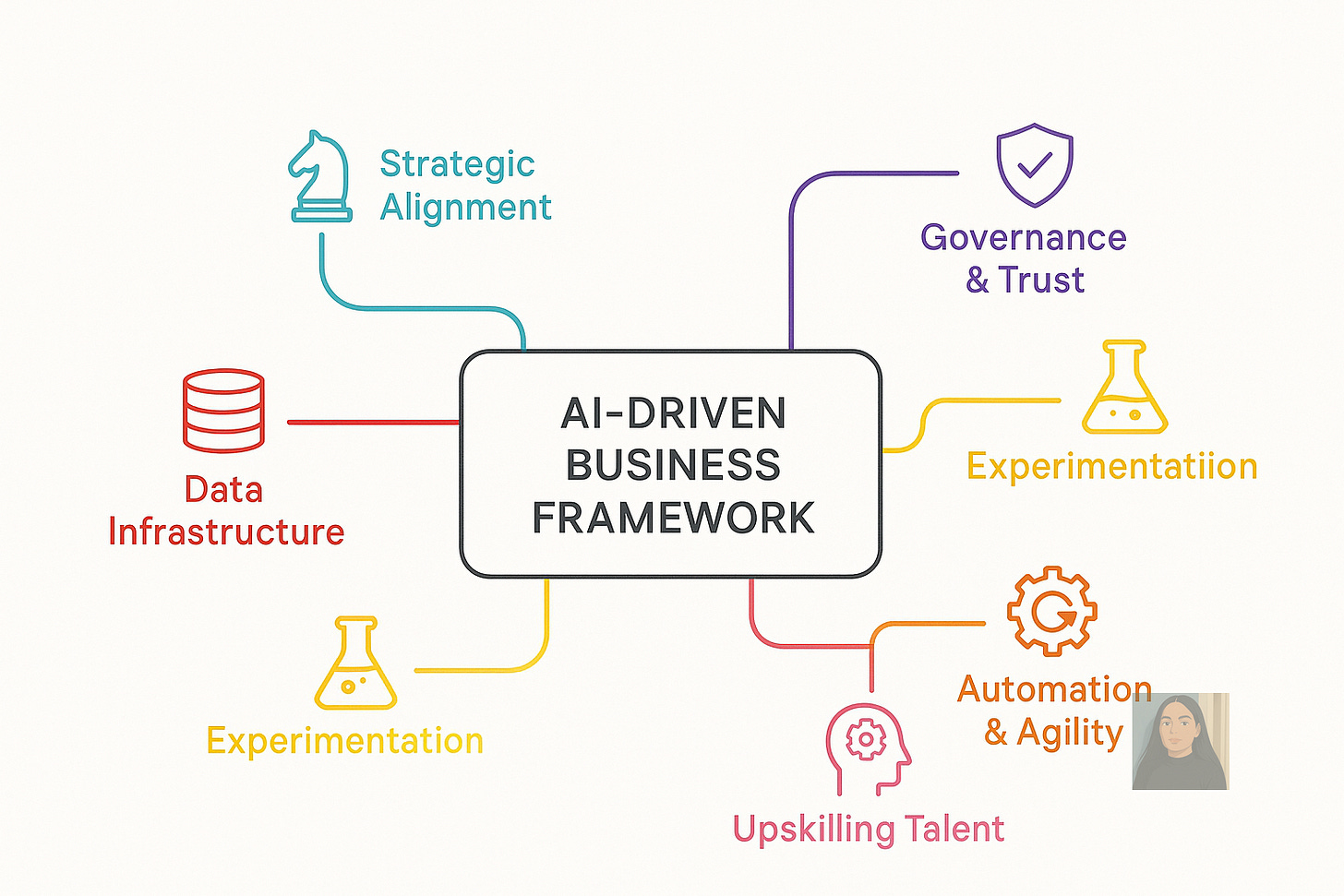
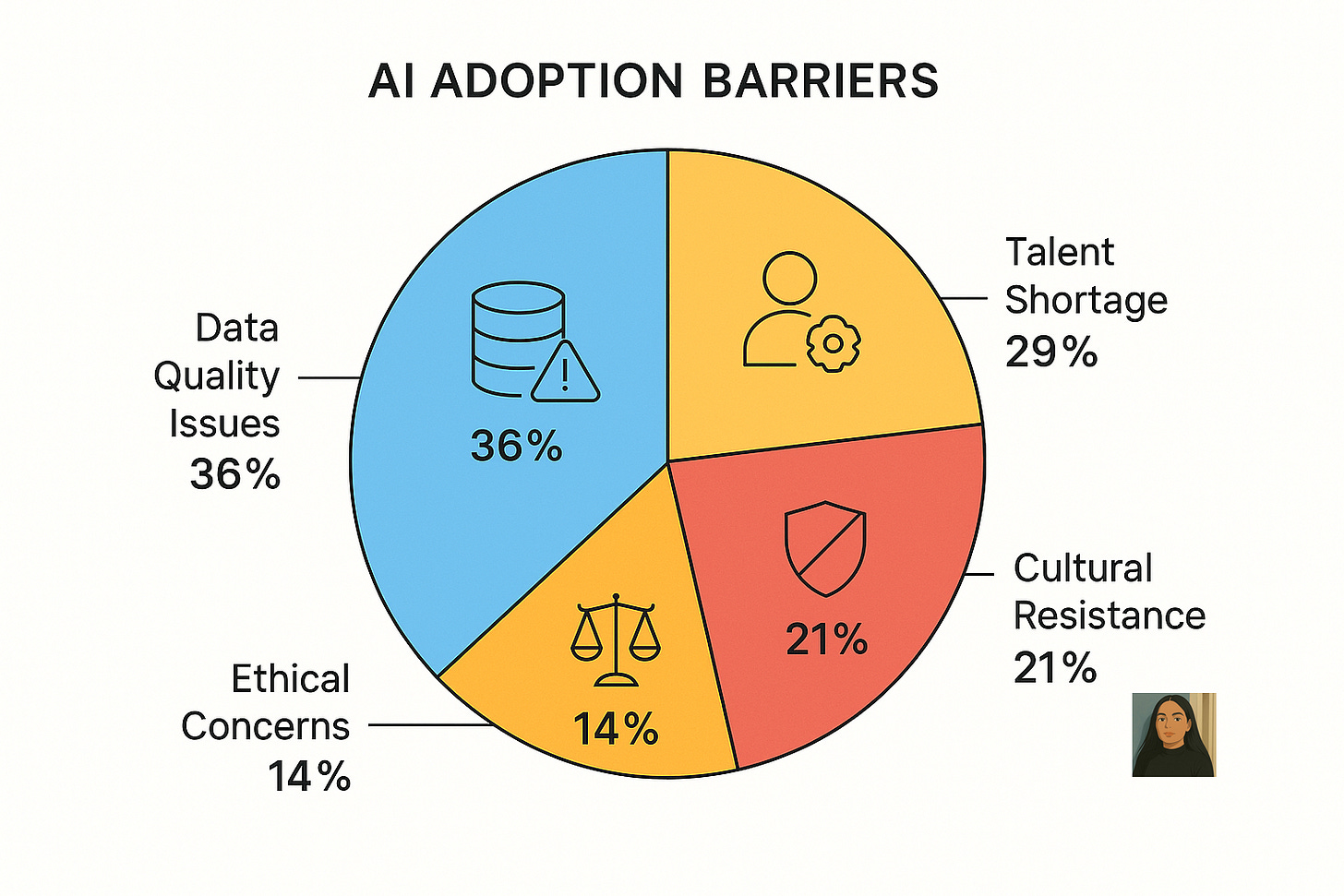
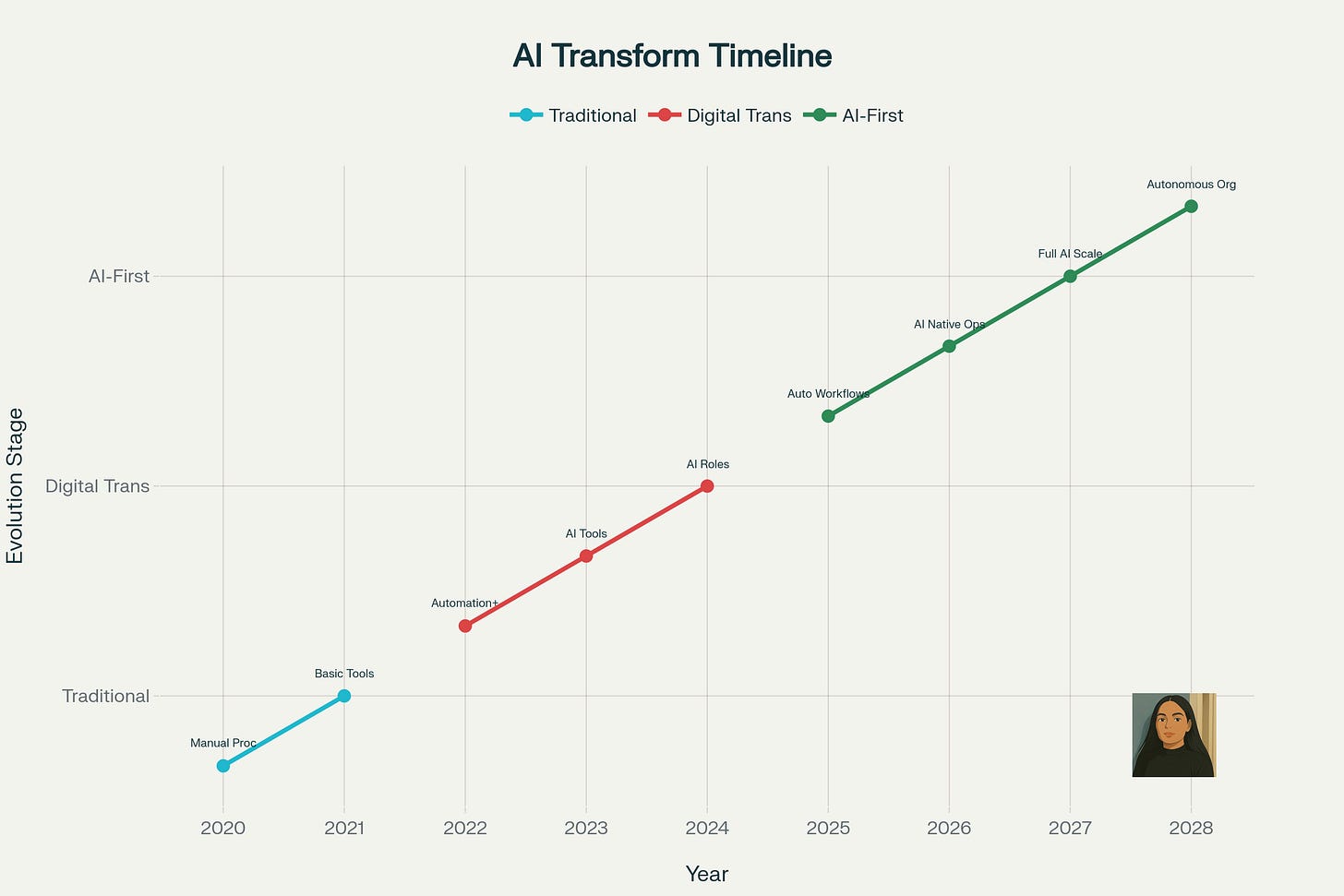
This is a brilliant roadmap. The "how" of building that lean, AI-native team is the critical next step, which is exactly what I help leaders navigate in The Efficiency Playbook. Thanks for the great summary.
loved this! amazing framing.
I build AI tools so I'm often around other AI companies. And a lot of the ones who succeed don't brainstorm "where can i use AI" but rather then think of what would become possible if they assume infinite cheap intel.
Totally different starting point!